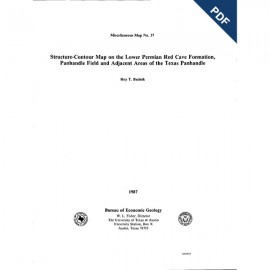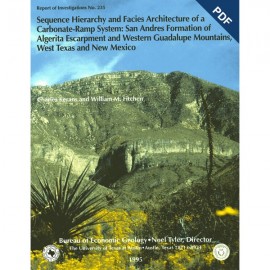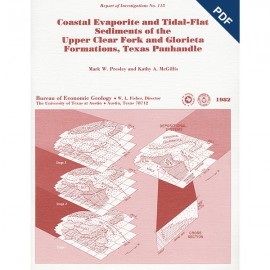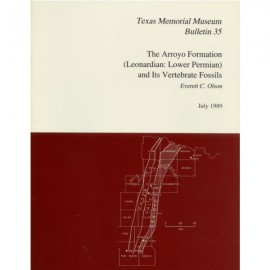Reports of Investigations
-
Books & Reports
- Reports of Investigations
- Guidebooks
- Udden Series
- Geological Circulars
- Down To Earth
- Atlases of Major Oil and Gas Reservoirs
- Texas Memorial Museum Publications
- Environmental Geologic Atlas of the Texas Coastal Zone
- Mineral Resource Circulars
- Other Reports
- Seminars and Workshops
- Handbooks
- Submerged Lands of Texas
- Symposia
- Annual Reports
- Open File Reports
-
Maps & Cross Sections
- Thematic Maps
- Miscellaneous Maps, Charts & Sections
- Geologic Atlas of Texas
- STATEMAP Project Maps
- Geologic Quadrangle Maps
- Cross Sections
- Highway Geology Map
- Energy and Mineral Resource Maps
- Shoreline Change and Other Posters
- Wilcox Group, East Texas, Geological / Hydrological Folios
- Bouguer Gravity Atlas of Texas
- River Basin Regional Studies
- Featured Maps
- Posters
- Teachers & the Public
-
Geological Society Publications
- Gulf Coast Association of Geological Societies
- Alabama Geological Society
- Austin Geological Society
- Corpus Christi Geological Society
- Houston Geological Society
- Lafayette Geological Society
- Mississippi Geological Society
- New Orleans Geological Society
- South Texas Geological Society
- GCS SEPM Publications
- Historic BEG & UT Series
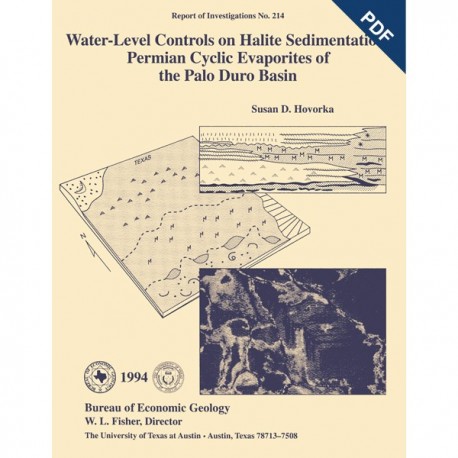
Water-Level Controls on Halite Sedimentation: Permian Cyclic Evaporites of the Palo Duro Basin. Digital Download
RI0214D
For a print version: RI0214.
RI0214D. Water-Level Controls on Halite Sedimentation: Permian Cyclic Evaporites of the Palo Duro Basin, by S. D. Hovorka. 51 p., 29 figs., 1 table, 2 pls., 1994. doi.org/10.23867/RI0214D. Downloadable PDF.
To purchase this publication in book format, please order RI0214.
ABSTRACT
Extensively cored cyclic evaporites of the San Andres Formation (Guadalupian) of the Palo Duro Basin, Texas Panhandle, provided fundamental information for interpreting evaporite depositional processes. These evaporites preserve exceptionally sensitive indicators of water-level fluctuation in their depositional environment: (1) sedimentary fabrics that formed during evaporite deposition; (2) sedimentary features, surfaces, and insoluble residues that formed during evaporite dissolution; and (3) diagenetic overprints that formed during evaporite brine evolution. Lateral and vertical facies relationships among evaporite facies defined on the basis of sedimentary fabrics were examined to document the evolution of the evaporite basin and the sedimentological response to water-level fluctuations.
San Andres evaporite sediments that were deposited in a variety of brine pool environments preserve evidence of water depth and brine pool character. Chevron structures defined by fluid inclusions trapped during crystal growth in halite indicate that the halite formed in very shallow, agitated and oxygenated water. Laminated, darker halite was interpreted to form in slightly deeper or more density-stratified brine pools by a combination of cumulate (surface-formed rafts) sedimentation and bottom growth. Facies relationships and fabrics indicate that bottom-grown fabrics in gypsum can form in slightly deeper water than bottom-grown fabrics in halite because density stratification in gypsum-saturated water is less.
This study documents using evaporite-dissolution features as paleoenvironmental indicators. Evaporite dissolution occurred (1) when water level rose and the evaporite basin became flooded by undersaturated marine water and (2) during emergence when water level fell and evaporites became exposed to undersaturated meteoric waters. The distinctive sedimentary fabrics and facies relationships created by both of these processes define the history of water-level fluctuation in the basin. High-frequency water-level fluctuation produced interbedded meter-thick zones of anhydritic halite (brine pool) and muddy halite (frequently exposed). Siliciclastic silt and clay concentration and structures that formed by karstic dissolution are recognized as evidence of exposure. Lower order cyclicity (parasequence scale) formed upward-shallowing cycles 2 to 30 m thick within the San Andres Formation. Insoluble residues that formed during the transgression that initiated cycles have a distinctive wavy "upside-down-accreted" fabric that may aid in identifying residues in other settings. Residue thickness was found to be inversely proportional to the amount of preserved halite in the underlying cycle. The relative timing of dissolution is documented by the facies and geometry of overlying sediments and by diagenetic phases incorporated in the residue.
Diagenetic overprints obscure primary textures in San Andres evaporites, but because the diagenesis is dominantly synsedimentary, it also provides information about the depositional environment. When water level fell, paleowater tables within the porous evaporites formed a vadose zone of halite dissolution and a phreatic zone of halite precipitation. The amount of brine pool fabric preserved is therefore a measure of water-level stability, in which the most altered fabrics are found to correspond to the highest frequency of fluctuation in updip or ephemeral environments.
The water-depth criteria developed by this study show that San Andres halite has preserved much depositional information and that cycle patterns in halite can be analyzed using the same techniques as are commonly used on carbonates. The techniques used in this study may be of use in other evaporite basins where water depth and basin evolution are unknown.
Keywords: cyclicity, depositional environment, evaporites, karst, salt
Contents
Abstract
Introduction
Geologic Setting and Basin Evolution
Methods
Cycle Patterns in the Palo Duro Basin
Description of Halite Rocks
Sedimentary Structures, Fabrics, and Interbeds in Halite Rocks
Cumulate Halite
Bottom-Nucleated Halite and Chevron Structures
Experimental Brine Pans
Dissolution Surfaces
Microkarst Pits and Pipes
Mudstone Interbeds in Halite
Chaotic Mudstone-Halite
Diagenetic Alteration of Halite
Classification of Halite
Depositional Facies Geometry in Halite Rocks
Definition of Facies in Halite Rocks
Anhydritic Halite Facies
Muddy Halite Facies
Detailed Halite Facies Cross Sections
Case Studies of Facies Relationships in Halite
Laterally Traceable Units--San Andres Unit 4, Zones 21 and 23
Geometry of Muddy Halite Facies--San Andres Unit 4, Zone 19
Geometry of Anhydrite Beds -
Thin Anhydrite Beds in Halite--San Andres Unit 4
Thin Anhydrite Beds in Halite--San Andres Unit 5
Interfingering Anhydrite-Halite Relationships
Dissolution during Transgression
Petrography of Base-of- cycle Dark. Anhydritic Mudstones
Small-Scale Example of Halite-Residue-Anhydrite Geometry, San Andres Unit 4,
Zones 24 and 25
Comparing Residue Thickness and Composition with Preserved Halite
Dissolution at the Top of San Andres Unit 4 and Formation of Residue at the Base of Unit 5
Origins of Cyclicity in the Guadalupian Series of the Palo Duro Basin
Discussion--A Depositional Model of Thick Sequences of Bedded Halite Rocks in the San Andres Formation
Brine Pool Geometry
Lateral Extent
Depth
Brine Pool Instability
Mudstone Deposition and Exposure
Microkarst
Causes of Restriction of Circulation
Summary and Conclusions
Acknowledgments
References
Figures
1. Geologic setting of the Permian Basin
2. Cross section A-A' of the Permian fill of the Palo Duro Basin
3. Stratigraphic nomenclature of the Permian strata of the Palo Duro Basin
4. Generalized Palo Duro Basin cycle composed of dark mudstone, carbonate, anhydrite, and halite
5. Summary of halite fabrics in the San Andres Formation, which compares fabrics seen in the San Andres with fabrics produced by modern or experimental halite precipitation
6. Photographs of color-banded cumulate halite
7. Photographs of chevron fabrics, defined by growth zones of halite rich in fluid inclusions alternating with clear halite
8. Photographs of truncation surfaces
9. Photographs of microkarst pits
10. Photographs of mudstone interbeds
11. Photographs of displacive halite in mudstone and chaotic mudstone-halite
12. Distribution of facies in San Andres unit 4, north-central Palo Duro Basin
13. Northwest-east cross section showing distribution of facies in five genetic cycles in San Andres unit 5
14. Northwest-southeast cross section showing distribution of facies in five genetic cycles in San Andres unit 5
15. Northwest-southeast cross section showing facies relationships and detailed correlation of thick and laterally persistent anhydritic halite
16. West-east cross section showing correlation of San Andres unit 4, zone 21, in Swisher County, demonstrating typical lateral variability of anhydritic halite
17. West-east cross section of San Andres unit 4, zone 19, showing typical variation in thickness and character of mudstone and muddy halite
18. Net-mudstone maps of San Andres unit 4: zone 1, zone 4, zone 6, zone 12, zone 22, and zone 24
19. South-north cross section of San Andres unit 4 anhydrite bed, zone 14, showing northward thinning into equivalent anhydritic chevron (Class A) and color-banded (Class B) halite
20. Map view of thickness of anhydrite beds in unit 4: zone 14, zone 16, and zone 26
21. West-east cross section of anhydrite bed, zone 15, San Andres unit 5, cycle 5c
22. Areal distribution of San Andres unit 5 anhydrite beds: cycle 5c, zone 15, cycle 5d, zone 17, and cycle 5d, zone 19
23. Photographs of dark, anhydritic mudstones at the base of San Andres cycles, strongly deformed and originating as insoluble materials derived from dissolution of halite rock
24. West-east cross section of zones 24 through 26 of San Andres unit 4 showing discontinuity of insoluble residue at the base of San Andres unit 4, zone 26
25. West-east cross section of zones 14 through 17 of San Andres unit 4 showing insoluble residue at the base of San Andres unit 4, zone 16
26. Distribution and thickness of anhydrite facies at the base of San Andres unit 5 and relationship to insoluble residue at the base of San Andres unit 5 and halite thinning at the top of unit 4
27. West-east cross section of facies and insoluble residue at the base of San Andres unit 5 and facies at the top of unit 4
28. Fischer plot of cycle thicknesses measured in DOE-Gruy Federal No. 1 Grabbe core
29. San Andres depositional environments, emphasizing scale and geometry of facies tracts relative to scale of study area, where brine pool is flooded, and gypsum and halite are deposited over wide areas; and where brine pool has shrunk, and evaporite-influenced mud flats have prograded over parts of the study area
Table
1. Textural classification of halite having genetic significance
Plates
1. Detailed cross section, San Andres unit 4, Palo Duro Basin
2. Detailed cross section, San Andres unit 5, Palo Duro Basin
Citation
Hovorka, S. D., 1994, Water-Level Controls on Halite Sedimentation: Permian Cyclic Evaporites of the Palo Duro Basin: The University of Texas at Austin, Bureau of Economic Geology, Report of Investigations No. 214, 51 p. doi.org/10.23867/RI0214D.

